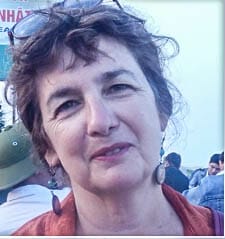She was shaking off all patina of being the scolding schoolmarm of Mary Cardwell Dawson we had become acquainted with in the past hour or so. Her voice seized the hall as she seductively raised her skirt to show more and more leg. In a blink and without need of costume change, Denyce Graves transformed herself to the title character of Carmen leaving the young talented tenor she seduced with her song wide-eyed, and perhaps more than a little terrified. Carmen,—as Dawson had drilled the young mezzo rehearsing for the role in the National Negro Opera Company’s performance— was a woman who knew her power, knew what she wanted, and didn’t dally getting it. That was also an apt description of Mary Cardwell Dawson, founder of the National Negro Opera Company we were learning in this opera biopic. For those of us who had seen red dress adorned Denyce Graves perform the role of Carmen at the Lyric or Met, it was as if history was a bullet ricocheting in a time tunnel. Carmen, Mary Cardwell Dawson, Graves —same, same, same. WOW! Step aside world and don’t get in their way!
North Carolina Opera Stages Powerful Volley in Battle Against Racism
All of the action takes place in a rehearsal room where Dawson drills her young talents à la Masterclass. To sidestep Jim Crow, they were about to perform Carmen on a Potomac-docked boat to an audience sitting on the lawn before them. This was a way to bypass the segregated seating restrictions of the time. It was an ingenious plan, but one that falls apart when the thunderstorms come. Dawson is faced with a life-changing decision for herself and her young charges. She could move the performance indoors, caving into Jim Crow and subjecting her audience to segregated seating. Or, she could cancel the performance and be penalized and closed down by the union for non-payment to the performers.
Playwright Sandra Seaton packs a lot of history into this re-telling of that moment and the battle Royale inherent in Dawson’s assertion that Black people were equals at opera performance, as in all spheres of life. You too might have found the slow start to the opera later leaving you surprised and scrambling to find tissues to wipe your tears at the dramatic end. As the tale unfolds, we are totally seduced by the talents on the stage. Joining world-famous diva Denyce Graves are tenor Johnnie Felder as Carmen’s Don José, mezzo Taylor-Alexis Dupont as Carmen, and coloratura soprano Diana Thompson-Brewer as homegirl Isabelle who tries to rescue Don José from his fate. They ham it up for comic effects that act like a pressure valve constantly relieving dramatic tension so we can take in more.
And they don’t just sing— they SING!!!— probably sending many, like this reviewer, eagerly scouring the Internet to find out where each is performing next.
Building Community with Opera Power
Following the performance scores of us went to explore the exhibit about Mary Cardwell Dawson and the National Negro Opera Company that Denyce Graves’ organization had compiled for this event. Still infused by the operatic drama from the stage, this writer imagines that we felt the way people did watching black and white newsreels in movie theaters pre-TV and during times of war.
As we circled the room, chairs were assembled in a circle and the post-performance talk by Angela Connor, Founder and Editor-in-Chief of the recently launched, ASCENDING Magazine. began by posing a question to us— Would we have been able to make the same decision that Mary Cardwell Dawson had made? We sat there and stood there— Black and White, young and old and in between— all having just shared in the drama of Mary Cardwell Dawson’s story. Frank, direct and insightful— the discussion built on the emotional momentum of the opera itself. Nobody said the word microagressions, but in this writer’s opinion, a very nuanced discussion of macro vs micro insults ensued, as well as insightful comments on how to navigate bringing awareness to the next generation of past battles, and those before us. Bravo to North Carolina Opera for using the power of opera to build community.
Bravos all around!
HIGHLY RECOMMENDED
Photos: Eric Waters, unless otherwise indicated.
Play by Sandra Seaton
Original music by Carlos Simon
Text for original music by Sandra Seaton
Commissioned by the Glimmerglass Festival
Mary Cardwell Dawson --- Denyce Graves
Frank --- Johnnie Felder
Isabelle --- Diana Thompson-Brewer
Phoebe --- Taylor-Alexis Dupont
Pianist --- Donald Lee, III
Director --- Kimille Howard
Lighting Designer --- Jessica Drayton
Music Director --- Donald Lee, III
Stage Manager --- Dustin Z. West
Production Manager --- Linda T. Carlson
Properties Master--- Pamela McLamb
Master Electrician --- Charlie Raschke
Costume Coordinator--- Denise Schumaker
Wig and Makeup Director --- Martha Ruskai
Original Sound Design --- Andrew Harper
Sound Designer --- Sean Loepp
Scenery designed by James F. Rotondo III
Costumes designed by Jessica Jahn
The scenery and costumes were originally created for the Glimmerglass Festival
A compelling exhibit summarizing the history of the National Negro Opera Company occupied a corner of the performance hall lobby. This exhibit was donated by The Denyce Graves Foundation.
This story has been added to the Picture This Post roundup article on OPERAS WE LOVE.
Watch this video preview here--

About the Author: Amy Munice
Amy Munice is Editor-in-Chief and Co-Publisher of Picture This Post. She covers books, dance, film, theater, music, museums and travel. Prior to founding Picture This Post, Amy was a freelance writer and global PR specialist for decades—writing and ghostwriting thousands of articles and promotional communications on a wide range of technical and not-so-technical topics.






















